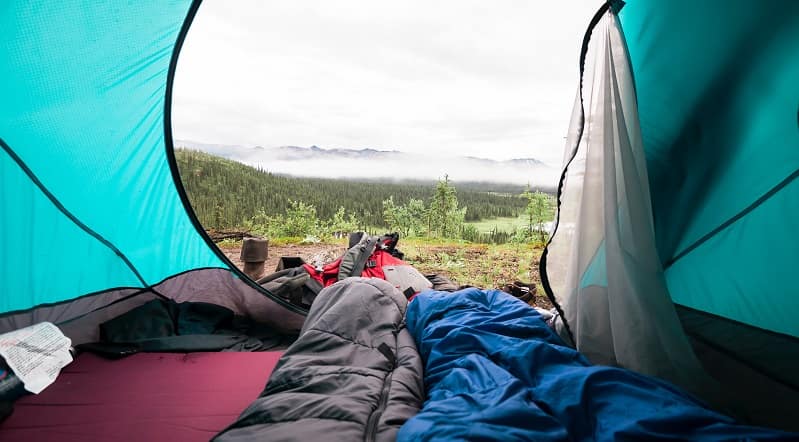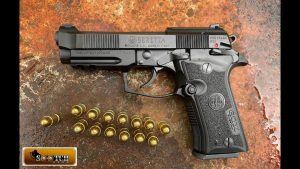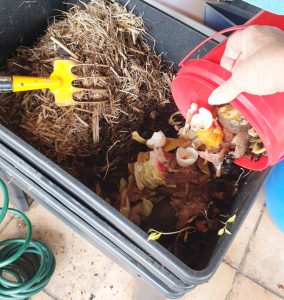There are many variables to consider when choosing an emergency sleeping bag. And these variables go way beyond just temperature rating and weight/size.
Here, I want to give you a clear overview of your options so you get the correct sleep setup for survival.
Bottom Line Upfront
Instead of just a survival sleeping bag, you will need a “sleeping kit.” That means a sleeping bag, sleeping pad, and shelter.
If you are a novice, you’ll need these as 3 separate pieces of gear. If you learn bushcraft survival skills, though – like how to make a camp bed – you may be able to skip some of the gear.
Survival Sleep Systems
1. Moderately Cold Sleeping Setup
For use with tent or tarp shelter.
Extremely-Cold Sleeping Setup
For use with 3 or 4-season tents. Doubling up the sleeping pads gives a combined R-value of 4.4.
Ultralight Sleeping Setup
For use with Tarp or Mylar blanket shelter.
How to Choose a Survival Sleeping Bag
Sleeping bag technology has come a long way over the past few decades. There are now dozens of different types and configurations. You could spend weeks reading about the features before making your purchase.
While you should learn about sleeping bags, I wouldn’t obsess too much about it. Why?
You’re better off thinking about scenarios where you’d realistically use the sleeping bag.
For example, a person living in Arizona would have very different needs than someone in New Hampshire.
It seldom gets below freezing in Arizona, nor do you have to worry about rain much. So an Arizonian could get by with a sleeping bag rated for lower temperatures. The person in New Hampshire would need a more robust setup to withstand thunderstorms and frigid temperatures.
Before you start looking, think about your Bug Out Plan.
Where will you be going?
How will you get there?
What conditions will you be sleeping in?
Once you know this information, you can choose the proper sleep setup. For more on this, read:
Once you’ve thought out your Bug Out plan, you can start thinking about the following features.
1. Temperature Rating
Good sleeping bags are tested using the EN13537 standard. It gives a range that the bag is suitable for.
Note that the lower limit temperature is usually given. For example, if a sleeping bag is rated for 30F, the bag will keep you alive at this temperature. But you will NOT be comfortable.
Instead, you want to pay attention to the comfort rating.
You might say that “comfort isn’t important” during survival. But let’s see you function after spending a night freezing your butt off at the lower limits of your sleeping bag!
Suggested Sleeping Bag Ratings:
- -40 to +4 F: If you will be in snow or ice. Also recommended for mountaineering expeditions.
- +5 to +29 F: This is a good range for various climates.
- +30 to +55 F: Choose for summertime or warm-weather activities at low elevations.
2. Filling
You have two main choices: down or synthetic.
For freezing weather, down is usually recommended. However, down sleeping bags can be very pricey, need to be fluffed, and aren’t as good as synthetic in wet situations.
For winter backpacking trips, down might be the best choice. But synthetic is probably the better choice for emergency bags and kits (like your BOB and car emergency kit).
Poor warmth-to-weight ratio
Making sense of synthetic technologies can be confusing
Down Fill Power, Weight, and Stitching
With down, you’ll need to pay attention to “fill power,” – which is how much space (loft) the down can fill when fluffed. The higher the fill power, the warmer the bag will be.
There is also down weight, which signals the amount of down used. More fill power or weight doesn’t always mean a warmer bag. For example, a sleeping bag with 500 fill power and 32oz. of down will be warmer than a bag with 800 fill power and 16oz. of down.
You can read a good guide to the difference between down fill and down weight here.
You’ll also need to pay attention to how the fill is stitched into the bag. The stitch greatly affects how well the bag “lofts” and whether the fill will get bunched in one area of the bag.
3. Shape
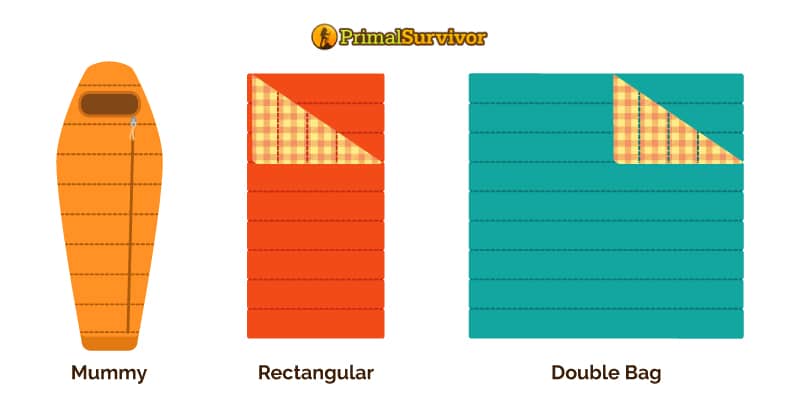
Some people will disagree with me but only choose a mummy sleeping bag for survival. This shape helps trap body heat best.
DO NOT GET:
- Double-wide sleeping bags: Sharing a sleeping bag might sound cozy, but it never works well in real life. The only exception is if you will be co-sleeping with a baby or young child.
- Rectangular or semi-rectangular sleeping bags: Aren’t as warm because you lose body heat to the areas that don’t fit your body shape.
Some professional-level sleeping bags for survival have made intelligent design choices for their bags. For example, you can get features like built-in footboxes for your feet or “stretch baffling,” so the bag stays around your body as you move around.
4. Size
I’m a 5’1? slim female. So, I need a smaller sleeping bag than a 6? tall man.
Why is size so important?
Because sleeping bags trap heat best when they fit your body, too much empty space in the sleeping bag will cause you to lose heat.
Likewise, you don’t want a sleeping bag that is too tight. You’ll end up crushing the insulation, and it won’t have the air pockets needed to trap heat.
Sleeping bag for plus-sized people?
Most sleeping bags are not made for husky people. So, you’ll find your options limited if you are a bigger person. Do NOT get a double-wide sleeping bag. It will be too wide to trap heat adequately. Instead, consider these good options:
- Use a blanket instead of a sleeping bag (like one of these top survival blankets)
- Choose a sleeping bag with an extra-wide option
Sleeping Pads Are Just As Important!
Good, lightweight sleeping pads can be costly. But (I can’t emphasize this enough), they are integral to staying warm while sleeping outdoors.
When sleeping bags are tested, it is with the assumption that you are using them with a sleeping pad underneath. Even a bag rated to -30F will NOT keep you warm if you sleep on cold ground!
For this reason, it is vital to consider your sleeping pad and survival sleeping bag.
Another plus of having a sleeping pad is using it to sit on. If the ground is wet, you’ll love that you can sit on your sleeping pad while preparing dinner or just taking a rest.
Cheap foam sleeping pads can be purchased for as little as $10 – especially in Army surplus stores. They usually only offer an R-Value of about 0.5-1 though. Self-inflating pads provide more comfort and a higher R-Value but are annoying to inflate when on the go.
Which Sleeping Pad for Winter Survival?
You will probably need TWO sleeping pads. Why? Because it is usually cheaper to buy two sleeping pads than one with a very high R-value.
Winter backpackers generally use this pad system:
- A self-inflating sleeping pad
- A closed-cell foam (CCF) pad is on top of this.
The CCF pad goes above the inflatable sleeping pad because you want the pad with the highest R-value to be close to your body. However, some backpackers put the CCF pad on the bottom for comfort reasons.
Sleeping Pad R-Value
Like other forms of insulation, sleeping pad warmth is rated with R-value. The chart below gives you an idea of how much R-value you need to stay warm – i.e., prevent the ground from sucking the heat out of you.
Remember that R-values are accumulative. You can put two sleeping pads on top of each other to combine their R-value. For example, a sleeping pad with an R-value of 2 on top of a pad with an R-value of 3 equals an R-value of 5.
[su_spoiler title=”R Values Table – Click to expand” class=”bottom-spoiler”]
| R-Value | Temperature in Fahrenheit |
|---|---|
| 1.2 | 48 |
| 1.6 | 46 |
| 2.1 | 36 |
| 2.9 | 28 |
| 3.2 | 23 |
| 4 | 12 |
| 4.6 | 5 |
| 4.9 | 1 |
| 5.3 | -4 |
| 5.9 | -11 |
| 7 | -26 |
| 8 | -36 |
Recommended Sleeping Pads
Knowledge Replaces Gear!
When you get more knowledge and experience, you can get rid of some gear. For example, instead of buying a sleeping pad, you could learn how to make a “bushcraft bed.” The bed elevates you, so the ground won’t act as a heat sink.
Raised-platform bushcraft beds can be very comfortable, so long as you add a layer of debris over the logs. The video below shows you how to make one.
Of course, this takes time – something you might not have in a survival/Bug Out situation. So, even if you have the knowledge, bringing a sleeping pad might still make sense.
What Shelter Will You Use?
It’s impossible to choose a survival sleeping bag without considering your shelter.
If you use your sleeping bag with a tent, you can get one with a lower temperature rating (since the tent will trap some body heat).
But if you are going to use your sleeping bag under a tarp, then you’ll need a much warmer sleeping bag or know survival skills like how to make a fire reflector.
I’d also avoid getting a down sleeping bag if you sleep under a tarp or debris shelter. Down doesn’t do well in wet situations; even a well-constructed shelter will likely let some moisture/rain through.
Read:
Best Emergency Survival Sleeping Bags
Because there are so many types of sleeping bags that could be used for survival, I’ve broken them into categories:
- Sleeping bags for extremely cold weather
- Sleeping bags for moderate-to-cold weather
- Lightweight survival sleeping bags
Bags For Extreme Cold (0°F and Below)
These sleeping bags are what you need for cold-weather bugging out (though you might want to consider bugging in in winter if you are in a very cold climate).
As discussed before, remember that it isn’t only the sleeping bag that matters. To survive outdoors in cold temperatures, you will need a good sleeping pad to prevent heat loss from the ground.
Winter backpackers use a closed-cell foam pad with an inflatable pad on top of it.
For sleeping pads, we recommend using a combo of the Therm-a-Rest Prolite Plus (R-value 2.4) AND the Z Lite SOL Ultralight (R-value 2) for a combined R-value of 4.4.
When used with a good sleeping bag, these should keep you alive and semi-comfy at temperatures below -11F.
Best Extreme Cold Option
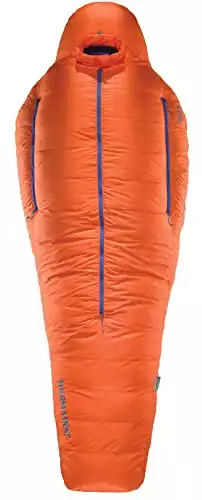
Therm-a-Rest Polar Ranger
If you’ve ever done any winter camping, you will realize what a serious survival sleeping bag this is. It is meant for mountain expeditions and is designed to keep you alive and comfortable in the worst conditions.
One of the standout features compared to other survival sleeping bags is the hydrophobic down filling, which stays dry (important when condensation starts forming in your shelter). The hood cinches up all the way so just your mouth and nose are exposed, keeping your face warm.
There are also two side vents on the sleeping bag. These have two purposes. First, they allow you to use your hands without having to open up the top of the sleeping bag. Secondly, they allow you to vent the sleeping bag so you can control the temperature. You don’t want to start sweating in the bag since that will make you cold.
All of these features do come at a steep cost, though!
Features:
- -4°F comfort rating
- -20°F limit rating
- Two sizes: regular (5’7” – 6’) and long (6’1” – 6’6”)
- 3lbs 4oz (regular), 3lbs 7oz (long)
- 800 fill hydrophobic down filling
- Snorkle hood
- Side vents
Complete Sleep System
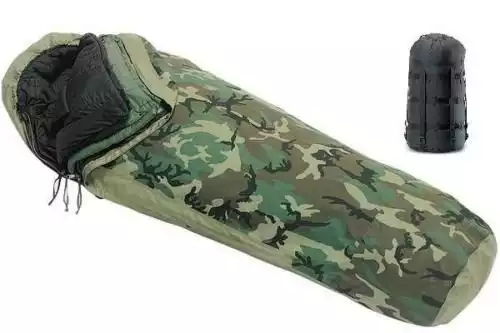
US Military 4-PC Weather Resistant Modular Sleep System
A lot of people swear by this survival sleep system. It is the setup used by the military, so it has been field-tested more than any other system.
However, I suspect that the popularity of the setup mostly has to do with the fact that it is military and thus seems most “rugged” or “manly.” I dislike this setup but decided to include it here because it is so popular.
This setup uses two mummy-style sleeping bags inside a waterproof bivy sack. Using both sleeping bags simultaneously means you can get down to -30°F. In warmer weather, you can use just one of the sleeping bags.
While it will keep you alive, there are some issues with using bivvy sacks as part of your survival sleep setup. The big problem is that you will get wet because condensation always builds up in bivvy sacks in cold weather. You are better off with a vented tent.
Another issue with this system is that it weighs 11lbs. You won’t want this in your BOB, but it would work for bugging out by vehicle. It’s also a good choice for your at-home emergency kit, such as staying warm during power outages.
Features:
- Comes with two sleeping bags (one rated to 30F and the other to -10F), a Gore-Tex bivy sack, and a compression sack
- Good down to -30F when both sleeping bags are used
- Multi-piece system means it is versatile
- Made in the USA
- 11lbs
Best Lightweight Option
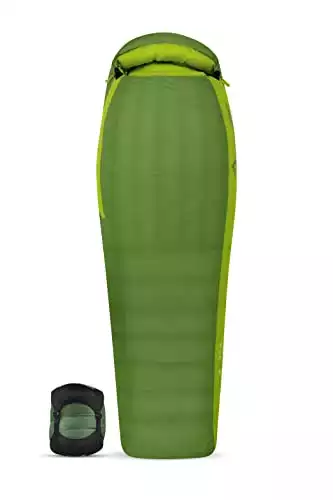
Sea to Summit Ascent 0-Degree Down Sleeping Bag
Sea to Summit is a well-known brand used by many professional backpackers. Their Ascent AcIII sleeping bag is not only warm enough for winter but light enough for BOBs.
The temperature rating for this sleeping bag is 0F, with a comfort rating of 15F.
One of the standout features of the Ascent is that it has an extra half zipper on the side. This allows for ventilation so you can easily adjust the temperature, meaning you can use it in warmer temperatures too.
There are two sizes of the bag: regular and long. It is a pricy sleeping bag, but you get what you pay for.
Features:
- Fits up to 72? Regular, 76? Long.
- Lower limit 0°F
- Comfort 15°F
- 750 fill power UltraDry down
- Water-resistant down
- Compresses to 8? x12?
- 2lbs 15oz (regular) 3lbs 3oz (long)
- Half-zip for ventilation
- Draft tube and fitted hood
- Internal pocket
Moderate-to-Cold Weather Bags (Lower Limit 1-22 F)
These sleeping bags probably won’t keep you alive once the temperatures get into the minuses. However, this does make them much more affordable.
They are also a lot lighter than 4-season sleeping bags. Choose one of these for situations like:
- Bug Out Bags in warmer climates
- Car emergency kits
- “Hunker down” kits for situations like power outages
Best Synthetic
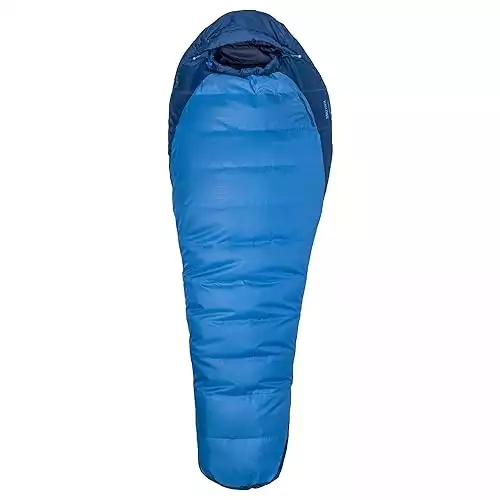
MARMOT Sleeping-Bags Trestles 15
This great synthetic sleeping bag keeps you warm in moderately cold weather but doesn’t cost a fortune. With survival skills like knowing how to make a fire and shelter, it will keep you alive in extreme cold.
Note that the temperature rating on this Marmot sleeping bag doesn’t seem to be realistic. It’s more likely good down into the upper 30s – but you will probably be very cold if you try to use it in the 15s.
The footbox is a bit drafty, so your feet may end up cold. It’s also a bit bulky, so not the most compact choice for BOBs.
However, it does everything you’d expect it to do and is much more affordable than professional-level sleeping bags.
Features:
- SpiraFil high-loft insulation
- Lower limit 15F
- Available in 82? or 88?
- 3lbs 6oz (regular) or 3lbs 12oz (long)
- Interior pocket
- Moisture resistant
Budget Pick For Moderate Temperatures
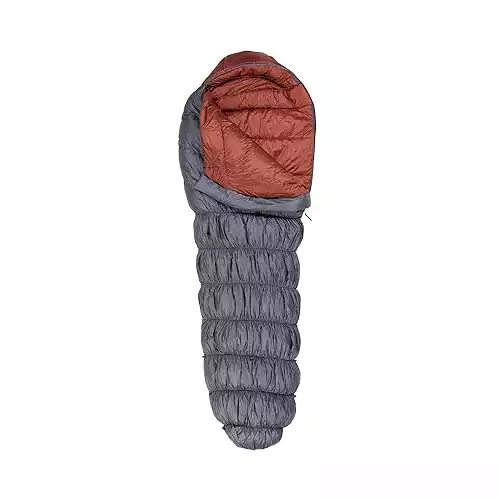
Klymit KSB 20°F Down
Klymit makes excellent backpacking gear, and their products don’t cost as much as other gear of the same quality (though don’t expect a 4-season sleeping bag to be cheap!)
This survival sleeping bag has some nice features, like adjustable length locks for people of different heights.
?The “stretch baffle” stitching keeps the down in place and near your body. Even if you move around a lot while sleeping, you will still have the same amount of insulation around you. Another cool feature is little pockets inside the sleeping bag for items like your flashlight.
Features:
- 650 down filling, 21.2oz weight
- 2.75lbs
- 10F lower limit, 23F comfort
- 5?
- Adjustable length locks
- Interior pocket
- Stretch baffle stitching
- Compresses to 13×8.5”
- Water-resistant
Budget Down Sleeping Bag
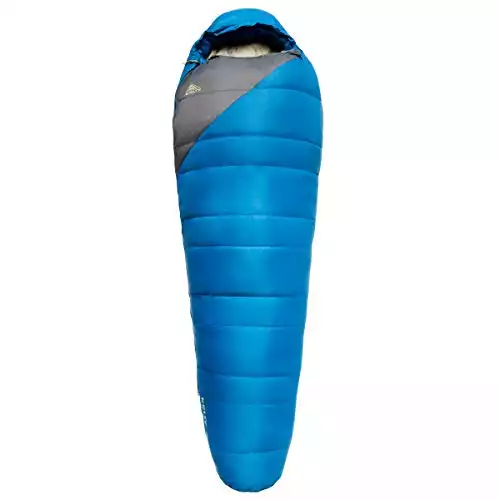
Kelty Cosmic 20
If you want a very affordable down sleeping bag for survival purposes, the Kelty Cosmic 20 is a good choice.
Unlike other cheap down sleeping bags, the temperature rating is pretty accurate. It will keep you comfortable at 32F.
Just remember that you’ve got to keep down bags dry and fluffed!
The bag has some nice professional features, like a draft collar and interior pockets. These small extras make it stand out from other survival sleeping bags in its price range.
Features:
- Down fill
- Lower limit 21F
- Fits 72? (regular) or 78? (long)
- 2lbs 10oz (regular) or 2lbs 15oz (long)
- Compresses to 8×13” (regular)
- Draft collar and hood
- Water-repellent coating
- Interior pocket
- Affordable option
Lightweight Bags (Under 2lbs)
If you are planning a Bug Out Bag, the weight matters. A 20lb pack might not seem heavy when you test it at home—but try trekking 15+ miles per day while wearing it.
The problem with lightweight survival sleeping bags is that they are either 1) really expensive or 2)not very warm. You’ll have to make a tradeoff between price, weight, and temperature.
That’s why it is essential to learn survival skills and get good gear. Also, read these tips for reducing weight from your Bug Out Bag.
The following bags weigh 2lbs or under but have varying prices and temperature ratings.
Best For Bug Out Bags
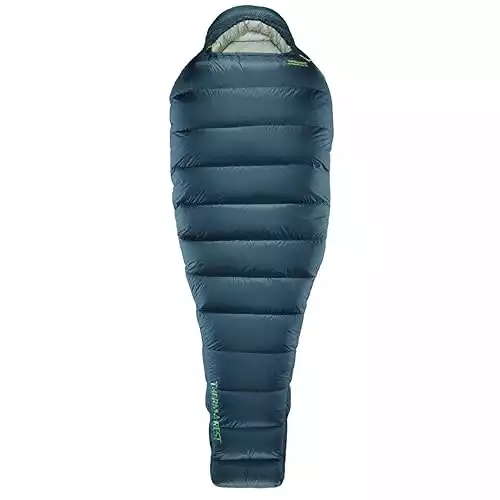
Therm-a-Rest Hyperion
This is by far the best sleeping bag for Bug Out Bags.
Why?
Because it is incredibly light at only 1lb, 4oz, yet has a lower limit of 20F. It packs down to just 6×8 inches.
The secret to the bag’s weight/warmth ratio is the high-quality down used. It also uses an intelligent design that utilizes space perfectly.
The only potential downside is that it is narrow, so it might not be the best solution for heavier people or people with broad shoulders.
As you’d expect with a lightweight sleeping bag rated for such low temperatures, the bag isn’t cheap — but it is worth it if you can afford it.
Features:
- 900 down fill
- Lower limit 20F
- 1lb 12oz (short) or 1lb 13oz( long), 1lb 15oz (extra long)
- Box baffle stitching
- Three sizes: 5’6?, 6?, and 6’6?
- Water-resistant down
- Compresses to 6×8” (regular)
- Full down collar
Budget Lightweight Pick
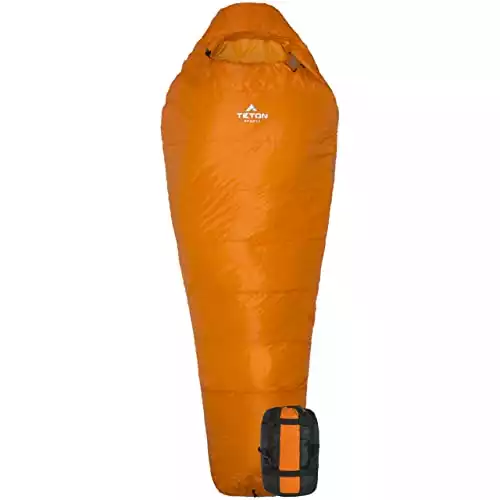
TETON Sports Altos-S 0F Ultralight
The Teton Sports Altos 0F is a great survival sleeping bag that also happens to be surprisingly affordable.
There are two versions of the 0F bag: synthetic and down. If you have never camped out in cold weather, I would suggest getting the synthetic version since you don’t have to worry about it getting wet like with the down version.
Features:
- Synthetic and down versions
- Lower limit 0F
- Fits up to 6?
- 3.5lbs
- Hood, draft tube and footbox
- Lifetime warranty







